What Does a Boat Subwoofer Do? Understanding Its Impact on Your Marine Audio System (2025)
A boat subwoofer delivers powerful low-frequency sounds that your deck’s regular speakers can’t achieve. It enhances your marine audio system by providing rich, deep bass, making your music experience on the water fuller and more enjoyable. This article will explain what a boat subwoofer does, its importance in marine environments, and why it’s important to take various factors into account when selecting a boat subwoofer for your marine audio system.
Key Takeaways
- Subwoofers enhance marine audio systems by managing low frequencies, allowing main speakers to focus on mid and high frequencies for improved sound clarity.
- Marine subwoofers are designed to withstand harsh environments, featuring waterproof surrounds and corrosion-resistant materials to ensure durability and optimal performance.
- Proper installation and the right pairing of subwoofers with amplifiers — and ensuring your subwoofer is matched with the correct amp — are crucial for achieving the best sound quality, avoiding distortion or damage, and maintaining the longevity of marine audio systems.
Enhancing Your Marine Audio Experience
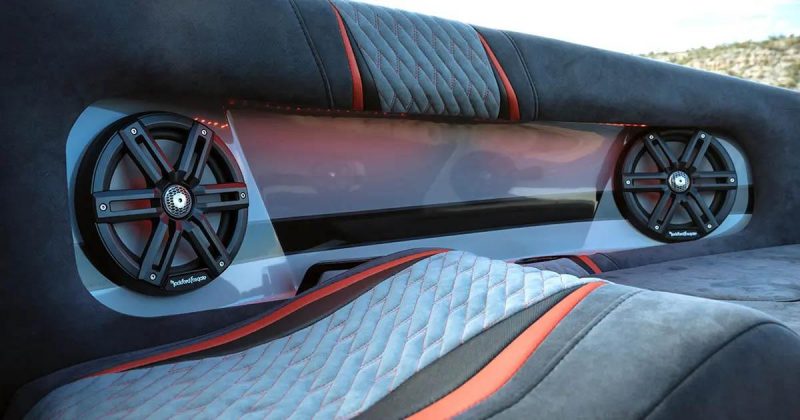
Feel the rhythm of the waves with Rockford Fosgate speakers.
A day on the water, whether it’s fishing, cruising, or partying, becomes exponentially more enjoyable with great music. The unsung hero of exceptional marine sound quality is the subwoofer. Subwoofers are vital for delivering those low-frequency sounds that add depth and richness to your audio experience. Since boats inherently work in “open air” environments, lower frequencies are hard to reproduce, because they typically require reflective surfaces commonly found in enclosed environments like cars, trucks, and SUVs.
Integrating subwoofers into your marine audio system allows your main speakers to focus on mid and high frequencies, enhancing overall sound clarity. This separation ensures that each element of your music is crisp and distinct, transforming your boat into a floating concert hall.
Adding a subwoofer can dramatically increase the volume and bass output, making your music not just heard but felt, and even louder. Even when the volume is cranked, the bass remains powerful and clear, ensuring your music maintains its impact at higher levels. Subwoofers manage the low frequencies, allowing the rest of your audio system to function without the strain of producing deep bass. The loud impact of a subwoofer enhances the overall listening experience.
In essence, a well-chosen subwoofer can upgrade your marine sound system from ordinary to extraordinary, creating a difference in the auditory experience that sounds great whether you’re in fresh water or salt water, especially when paired with a quality speakers.
The Role of Subwoofers in Marine Environments
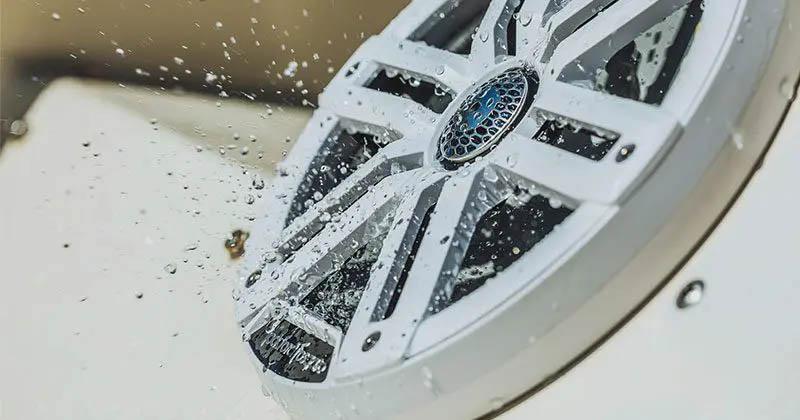
Embrace adventure with confidence using rugged, waterproof Rockford Fosgate marine speakers and subwoofers.
Marine environments are notoriously harsh, with constant exposure to UV rays, saltwater, and high humidity. Quality marine subwoofers are specifically designed to withstand these rigorous conditions, ensuring longevity and optimal performance.
These subwoofers feature waterproof surrounds that protect against moisture damage, crucial for maintaining sound quality in wet conditions. Marine subwoofers also employ corrosion-resistant materials like aluminum frames and polypropylene cones with UV inhibitors, which resist the deteriorating effects of on-the-water exposure. Some subwoofer enclosures use treated wood or marine-grade wood, properly sealed to resist water and salt, providing added durability and improved acoustic performance in marine environments.
Additionally, marine subwoofers incorporate rubber surrounds and marine-grade wiring to maintain flexibility and prevent water damage. These features ensure that your subwoofer will continue to produce high-quality sound, no matter what the marine environment throws at it.
Key Features of Boat Subwoofers
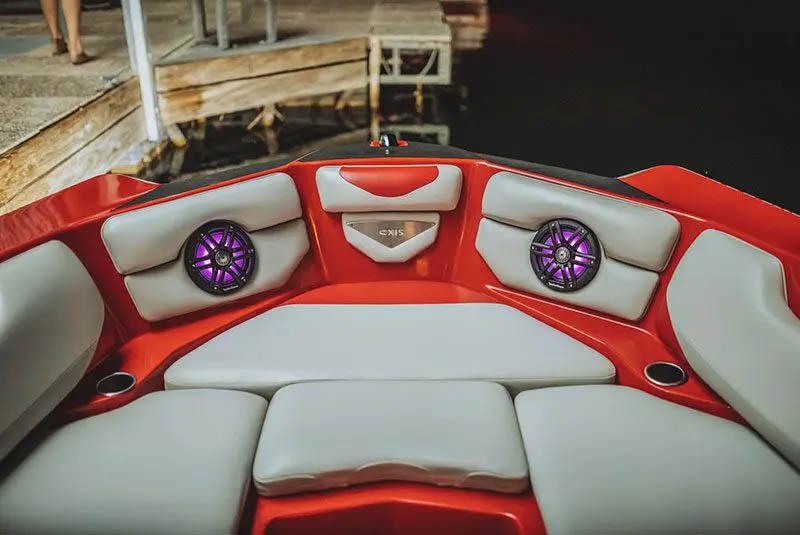
Rockford Fosgate speakers elevate the boat audio experience with stunning visuals and sound.
Selecting the right boat subwoofer involves understanding several key features that contribute to sound quality and durability, including:
- Power handling & Impedance
- Size (a larger surface area allows the subwoofer to move more air, resulting in deeper and more powerful bass.)
- Enclosure space
These features determine how well the subwoofer will perform in your specific setup. If you need help determining how much space you have for a subwoofer, you can use our Woofer BoxWizard to calculate your available space.
Durability and weather resistance are also crucial, ensuring that your investment lasts through many boating seasons.
Power Handling and Impedance
Power handling is a critical specification in subwoofers, indicating how much power they can manage without distortion. The RMS rating shows the continuous power output a subwoofer can handle, providing insight into its sustained performance. More power, on the other hand, refers to the maximum power a subwoofer can handle in short bursts, important for those dramatic moments in your favorite tracks, measured in watts.
In addition to power ratings, subwoofers have impedance ratings measured in ohms. Matching the subwoofer’s impedance with your amplifier is important for optimal performance, as it affects power handling, wiring options, and overall system compatibility.
Understanding both RMS and Impedance ratings helps ensure you choose a subwoofer that matches your performance needs and your amplifier’s capabilities. Moreover, proper power handling ensures that your subwoofer produces clear, powerful bass without risking damage from being overpowered.
Size and Enclosure Space
The size of a subwoofer significantly influences its sound quality. Larger subwoofers generally produce deeper bass, but they also require more enclosure volume to perform optimally. This means that adequate enclosure space is critical for achieving the best sound quality. When designing the enclosure, it is essential to create the correct size hole for the subwoofer, as this ensures proper installation and optimal sound quality.
Marine environments often require sealed or ported enclosures for subwoofers to function effectively. Enclosed subwoofers are designed to operate within a fixed air volume, enhancing sound quality compared to open-air setups, which can result in muffled sound when mounted improperly. A well-designed box can further improve performance in the air space and port.
If you have an irregular area to contain the subwoofer, Rockford Fosgate offers Infinite Baffle subwoofers that don’t need an enclosure. Infinite Baffle subwoofers have a more robust suspension and simply require a “baffle” to work (a baffle is simply a divider that separates the air behind the subwoofer from the air in front of the sub).
Durability and Weather Resistance
Durability and weather resistance are paramount when choosing a marine subwoofer. High-quality materials like fiberglass and marine-grade plastics ensure longevity and consistent performance.
Construction features such as sealed enclosures and marine coatings provide protection against moisture and UV rays, preventing deterioration from the harsh marine environment. Corrosion-resistant materials also play a crucial role in maintaining the subwoofer’s functionality over time.
Installation Considerations
Proper installation of your subwoofer is essential for optimal performance. Installing a subwoofer in different locations on the boat, such as in the hull, enclosures, or pre-built sealed boxes, can significantly affect both performance and aesthetics. Two smaller subwoofers can often fit more discreetly into a boat’s design than one larger subwoofer, offering aesthetic flexibility. Properly installed insulation can also prevent vibrations from affecting the boat’s structure. To ensure the best results, always install your subwoofer according to the manufacturer’s guidelines.
Selecting the right location and ensuring proper wiring and amplifier pairing are critical steps in the installation process. These considerations will help you achieve the best sound quality and reliability from your marine audio system.
Selecting the Right Location
The placement of your subwoofer significantly impacts the overall sound quality on your boat. Common installation spots include under the helm, seats, or in the cockpit, where the subwoofer can take advantage of reflective surfaces needed to properly develop the longer waves that subwoofers require.
Positioning the subwoofer on a boat can be optimized by considering the following options:
- Near the boat’s stern: enhances bass response due to better sound wave reflection.
- Near seating areas: ensures an immersive audio experience for everyone on board.
- Under-seat compartments: offer protection against elements and accidental damage.
- In the bow: installing a subwoofer in the bow can affect bass response and may require careful consideration of enclosure design.
- Access doors or panels: consider whether access doors or panels will need to be installed or modified to accommodate the subwoofer and ensure proper installation and maintenance.
Wiring and Amplifier Pairing
Pairing your subwoofer with an amplifier is crucial for optimal performance. It’s important to pair your subwoofer with an amplifier that matches its impedance rating, typically measured in ohms, to ensure proper power handling and prevent damage to your equipment. Rockford Fosgate subwoofers utilize VERSA technology that allows you to simplify impedance wiring with a switch. Keeping the subwoofer close to the amplifier reduces cable length, minimizing signal loss and improving sound quality. Shorter cables also prevent potential hazards like snagging on boats.
Using marine-grade wiring ensures resistance to water damage and UV exposure, maintaining reliable connections and performance to connect.
For more marine audio tips, explore Rockford Fosgate’s knowledgebase at https://rockfordfosgate.zendesk.com/hc/en-us, where you can search for articles.
Subwoofer Maintenance and Upkeep
Maintaining your boat’s subwoofer is essential for preserving sound quality and ensuring your marine audio system stands up to the challenges of the marine environment. Regular upkeep not only extends the life of your subwoofer but also guarantees that your music always sounds great, whether you’re cruising in fresh water or out at sea.
Start by routinely cleaning the subwoofer and its surrounding storage area. Dust, debris, and moisture can accumulate quickly on boats, potentially affecting the performance of your subwoofer and disrupting sound waves. Wipe down the subwoofer’s surface and check for any buildup that could impact audio output.
Inspect the sealed enclosures and wiring for any signs of wear, corrosion, or damage. In a marine environment, even the best marine-grade wiring and sealed enclosures can degrade over time. Ensuring that all connections are secure and that the enclosure remains airtight will help maintain optimal sound quality and prevent unwanted air leaks that can diminish bass response.
If your boat is equipped with multiple subwoofers, make sure each subwoofer is properly installed and configured. Proper installation is key to producing balanced, powerful bass and avoiding issues like phase cancellation, which can reduce the overall impact of your audio system. Double-check that each subwoofer has enough air space to operate efficiently, especially if you’re using an infinite baffle setup, where the subwoofer relies on the boat’s structure for its enclosure.
Power handling is another critical aspect of subwoofer maintenance. Avoid overpowering your subwoofer, as excessive power can cause permanent damage to the cone or voice coil. If you want more power and louder output, ensure your amplifier and subwoofer are correctly matched and that your subwoofer has the necessary air space to produce deep, distortion-free bass.
Leading marine audio brands like Rockford Fosgate recommend regular maintenance checks to keep your subwoofers performing at their best. This includes inspecting for water intrusion, checking the integrity of sealed enclosures, and verifying that all wiring is intact and corrosion-free.
Finally, consider the location and protection of your subwoofer when your boat is not in use. If your subwoofer is installed in a storage area or under a seat, make sure it’s shielded from direct exposure to water and physical damage. Using marine-grade covers or enclosures can add an extra layer of protection.
By following these maintenance and upkeep tips, you’ll ensure your subwoofers continue to deliver high-quality sound and make a noticeable difference in your marine audio experience, season after season. Proper care means your system will always be ready to produce the powerful bass and clear audio that make every outing on the water unforgettable.
Types of Marine Subwoofers
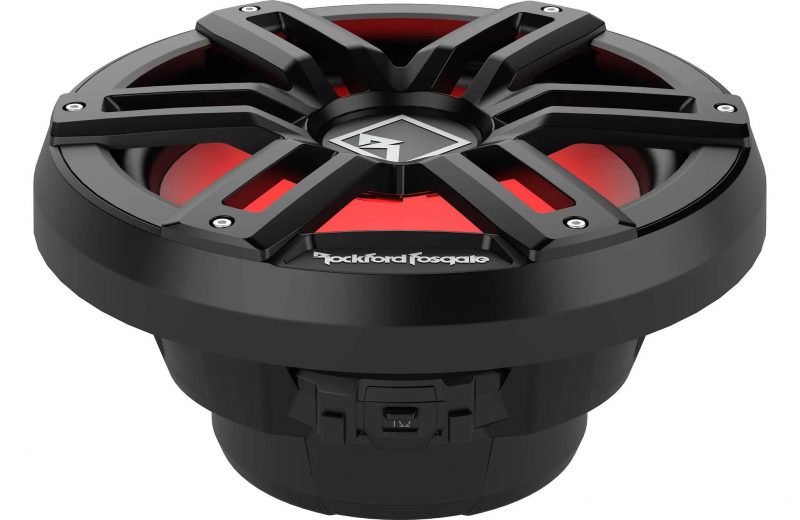
Trust in the quiet strength of this Rockford Fosgate marine speaker, designed to endure.
Marine subwoofers come in various designs, each with its advantages and considerations:
- Sealed enclosures provide tighter bass.
- Ported enclosures allow for more boom but require adequate space.
- Infinite Baffle subwoofers can be installed directly in the hull, saving space and simplifying installation.
While both subwoofers and woofers are designed to handle low frequencies, subwoofers are specialized for deep bass, which is especially important in marine environments where open air can diminish low-end response. Using multiple subwoofers can further optimize bass output and sound quality throughout the boat.
Subwoofer size must be balanced with available space on the boat, and larger models do not always guarantee better sound quality. Specialized designs can work effectively in smaller spaces, ensuring optimal sound even with limited room.
Benefits of Adding Multiple Subwoofers
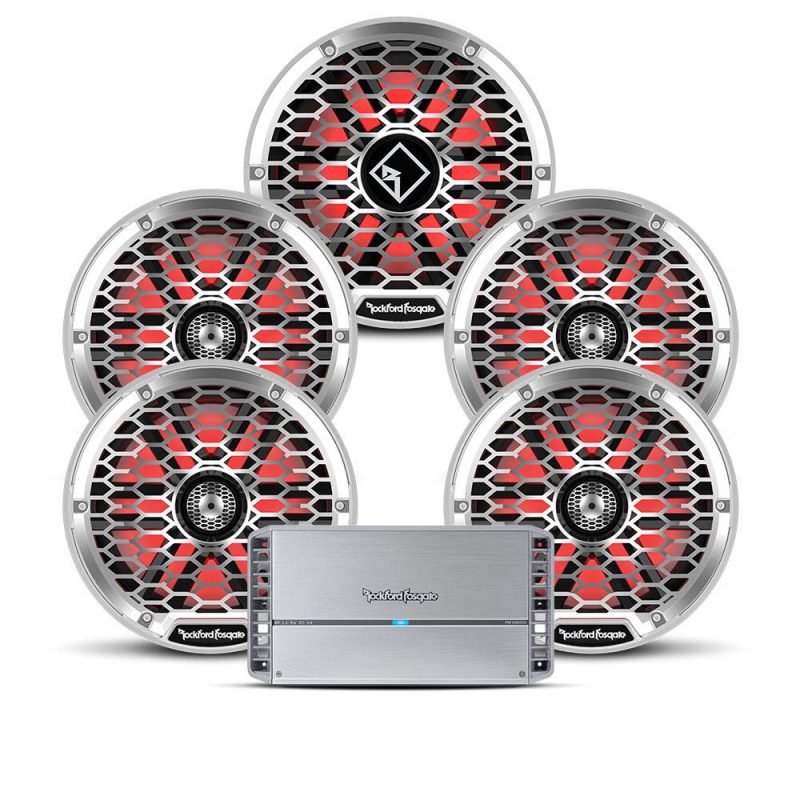
Immerse yourself in a dynamic soundscape with a Rockford Fosgate multi-subwoofer system.
Using multiple subwoofers can significantly enhance the overall loudness of your marine audio setup, creating a more immersive experience. Dual subwoofers enhance dynamic range and reduce distortion, resulting in cleaner, more precise bass during high-volume playback. Pairing multiple subwoofers with tweeters helps create a more balanced and immersive soundstage on your boat, ensuring full-range audio performance.
Multiple subwoofers offer several benefits:
- They lead to a smoother bass response across various listening positions due to overlapping modal patterns.
- They contribute to a more cohesive soundstage.
- They make the bass feel like it surrounds the listener, enhancing the experience with subs.
Common Myths About Boat Subwoofers
Several misconceptions exist about boat subwoofers. For example, some people have figured that bigger subs always sound better, but that’s not really true. Proper installation and matching the subwoofer to the enclosure are far more important. Don’t forget that spending more money on a subwoofer doesn’t always guarantee better sound quality; a well-installed, properly powered setup can outperform a more expensive but poorly installed system.
Understanding these myths helps in making informed decisions and optimizing your marine audio system to create the best performance.
Summary
Updated for July 2025, this article explains the impact of boat subwoofers on marine audio systems. In summary, a boat subwoofer can drastically improve your marine audio experience, providing rich, deep bass and enhancing overall sound quality. By understanding the key features, installation considerations, and debunking common myths, you can make informed decisions to elevate your boating adventures. Transform your marine audio system with the right subwoofer and enjoy a symphony on the waves.
FAQ
Why is a subwoofer important in a marine audio system?
A subwoofer is crucial in a marine audio system because it enhances low-frequency sounds, resulting in richer and clearer audio quality that enriches your overall listening experience on the water.
What features should I look for in a marine subwoofer?
Look for power handling, appropriate size, suitable enclosure space, and durability against marine conditions to ensure optimal performance and longevity of your marine subwoofer.
How does the placement of a subwoofer affect sound quality?
The placement of a subwoofer significantly affects sound quality; positioning it near the seating area with reflective areas can enhance bass response and overall listening experience. Proper placement is key to achieving optimal audio performance.
Can I use multiple subwoofers on my boat?
Yes, you can use multiple subwoofers on your boat, as they can significantly enhance loudness and bass response, resulting in a more immersive audio experience.
Do I need a powerful amplifier for my subwoofer?
You don’t necessarily need a powerful amplifier for your subwoofer; proper matching and setup can deliver excellent performance even with lower power ratings. Focus on achieving the right balance for optimal sound quality.
How does Rockford Fosgate ensure subwoofer durability in 2025?
Rockford Fosgate ensures subwoofer durability in 2025 with Element Ready™ technology, featuring waterproof surrounds, corrosion-resistant materials like UV-stable ASA plastic and polypropylene cones with UV inhibitors, and gold-plated brass terminals, all designed to thrive in harsh marine conditions.